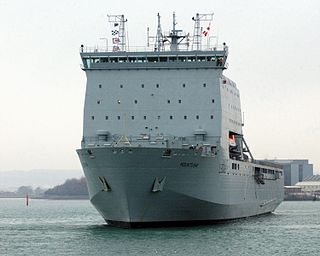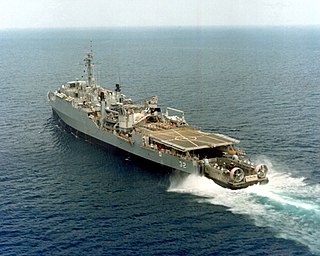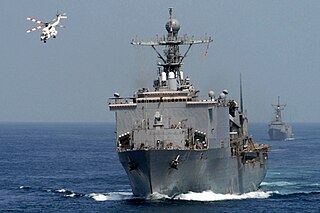Tortuga is the Spanish word for a turtle or tortoise. It may also refer to:
Tortuga is the Spanish word for a turtle or tortoise. It may also refer to:

Tortuga Island is a Caribbean island that forms part of Haiti, off the northwest coast of Hispaniola. It constitutes the commune of Île de la Tortue in the Port-de-Paix arrondissement of the Nord-Ouest department of Haiti.

The Bay class is a ship class of four dock landing ships built for the British Royal Fleet Auxiliary (RFA) during the 2000s. They are based on the Dutch-Spanish Royal Schelde Enforcer design, and replaced the Round Table-class logistics ships. Two ships each were ordered from Swan Hunter and BAE Systems Naval Ships. Construction work started in 2002, but saw major delays and cost overruns, particularly at Swan Hunter's shipyard. In mid-2006, Swan Hunter was stripped of work, and the incomplete second ship was towed to BAE's shipyard for completion. All four ships, Largs Bay, Lyme Bay, Mounts Bay, and Cardigan Bay had entered service by 2007.
Two dock landing ships of the United States Navy have been named USS Tortuga, after the Dry Tortugas, islands off Florida.

USS Tortuga (LSD-26) was a Casa Grande-class dock landing ship in the United States Navy. She was the first Navy ship to be named for the Dry Tortugas, a group of desert coral islets 60 miles west of Key West, Florida, which were discovered in 1513 by Spanish explorer Ponce de Leon.

USS Spiegel Grove (LSD-32) was a Thomaston-class dock landing ship of the United States Navy. She was named for Spiegel Grove, the home and estate in Fremont, Ohio, of Rutherford B. Hayes, the 19th President of the United States.

USS Whidbey Island (LSD-41) is a Whidbey Island-class dock landing ship (LSD) of the United States Navy. She was named for Whidbey Island, in Puget Sound, Washington, the location of NAS Whidbey Island; the name ultimately derives from the sailor, explorer and engineer Joseph Whidbey.

USS Gunston Hall (LSD-44) is a Whidbey Island-class dock landing ship of the United States Navy. She was the second Navy ship to be named for Gunston Hall, the Mason Neck, Virginia, estate of George Mason, one of Virginia's Revolutionary figures, and "Father of the Bill of Rights". Gunston Hall was laid down on 26 May 1986, at the Avondale Shipyards, New Orleans. The ship was launched on 27 June 1987, commissioned on 22 April 1989 and assigned to Naval Amphibious Base Little Creek.

USS Tortuga (LSD-46) is a Whidbey Island-class dock landing ship of the United States Navy. She was the second Navy ship to be named for the Dry Tortugas, a group of desert coral islets 60 miles (97 km) west of Key West, Florida.

USS Carter Hall (LSD-50) is a Harpers Ferry-class dock landing ship of the United States Navy. She is the second US Navy ship to be named for Carter Hall, an estate near Winchester, Virginia, built in the 1790s.
Tortuga, Tortuga Isle, or Tortuga Island may refer to:

The Whidbey Island-class dock landing ship is a dock landing ship of the United States Navy. Introduced to fleet service in 1985, this class of ship features a large well deck for transporting United States Marine Corps (USMC) vehicles and a large flight deck for landing helicopters or V-22 Ospreys. The well deck was designed to hold four LCAC hovercraft, five if the vehicle ramp is raised, for landing Marines. Recent deployments have used a combination of LCU(s), AAVs, tanks, LARCs and other USMC vehicles. The Whidbey Island class of ship also uniquely benefits from multiple cranes and a shallow draft that further make it ideal for participating in amphibious operations.

USS Shadwell (LSD-15) was a Casa Grande-class dock landing ship in the United States Navy. She was named after Shadwell plantation, Albemarle County, Virginia, the birthplace and early home of Thomas Jefferson, author of the Declaration of Independence and third President of the United States.

The Anchorage-class dock landing ships were a series of five dock landing ships (LSD) constructed and commissioned by the United States Navy between 1965 and 1972. US Navy decommissioned all five of them by 2003. They are succeeded by Whidbey Island-class LSDs and Harpers Ferry-class LSDs.

USS Pandemus (ARL-18) was one of 39 Achelous-class landing craft repair ships built for the United States Navy during World War II and was in commission from 1945 to 1946 and from 1951 to 1968. Named for Pandemus, she has been the only U.S. Navy vessel to bear the name.

USS Cambria (APA-36) was a Bayfield-class attack transport acquired by the U.S. Navy for service in World War II. She was named after Cambria County, Pennsylvania
The following index is provided as an overview of and topical guide to Wikipedia's articles on recreational dive sites. The level of coverage may vary:

Recreational dive sites are specific places that recreational scuba divers go to enjoy the underwater environment or for training purposes. They include technical diving sites beyond the range generally accepted for recreational diving. In this context all diving done for recreational purposes is included. Professional diving tends to be done where the job is, and with the exception of diver training and leading groups of recreational divers, does not generally occur at specific sites chosen for their easy access, pleasant conditions or interesting features.